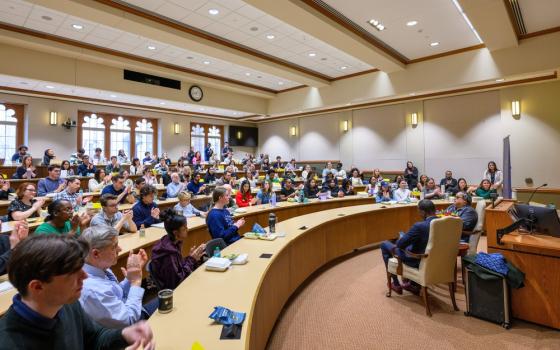"I won't be coming in to speak with the religion classes anymore."
For decades, the sister had shared with students the history of her Ursuline order. She served our all-girls' high school, Saint Ursula Academy, as a teacher, guidance counselor, campus minister, and more. In later years, she relished storytelling about the Ursuline foundress, St. Angela Merici.
For thousands of her high school "daughters" -- myself included -- this sister offered a model of strength, faithfulness and good humor. Faculty and staff sought out her steadfast listening presence. She bound our community to a rich Ursuline identity.
Having returned as a religion teacher, I stood again in her office. Outside the door, her nameplate was inscribed "Grandmother-in-Residence." She repeated herself, as if getting accustomed to the statement:
"I won't be coming in to speak with the religion classes anymore."
With her words, my heart sank. I knew the day was coming. When it did, however, an unexpected weight surfaced with my sadness. "How am I going to teach without her to share our history? To keep it alive?" Daily, these questions continue to challenge me, our religion department and, indeed, our whole school community.
We are not alone. As the numbers of U.S. women religious continue to decline, the handing on of charism is emerging as a central concern. Schools, hospitals, social service organizations and more: the institutions -- and legacies -- cultivated by vowed religious are being entrusted, increasingly, to new lay leaders. Such a transition is filled with challenge and possibility.
"How does one catch the spirit?" The situation is aptly phrased by Sr. Margie Efkeman, General Minister of the Ursulines of Cincinnati.
For our high school, built on the sisters' daily presence, ingenuity and perseverance, the question of transmitting charism demands a creative response. Indeed, times have changed. Sisters no longer run the school, teach in classrooms, or eat one egg weekly to keep down tuition costs.
In recent years, the school has undergone further transformation. We've expanded our campus and renovated buildings. Girls do not encounter sisters tending the academy gardens or returning from daily Mass. My classroom inhabits the former convent, transformed into a school wing after the sisters decided to move into a separate healthcare facility.
"The move was really difficult -- heartbreaking," a parent recounted. Her daughter joined the first class of students to enter without any sisters living on campus. No longer would charism be unconsciously, powerfully passed through their presence alone. "By osmosis," one sister quipped.
Today, charism cannot survive unarticulated. It must be spoken and shared -- consciously named and, in this naming, live.
How?
No roadmap has been offered for the transition. These sisters have learned by forging their own path.
In fact, you needn't look far to discover a religious order that, in one way or another, is stepping into a vastly transformed future. Reflections offered by Ursulines help me to appreciate this process unfolding in my own school. From them, I've begun to sense the courage needed to articulate, and then transmit, one's charism beyond a vowed community.
Without doubt, this courage has enabled the Ursulines of Cincinnati to proactively cultivate new generations of lay leadership for our academy. In the mid-1980s, the sisters established a lay advisory board to support their school administration. Now, with the institution entrusted to a board of trustees, greater effort has been made to foster this Ursuline charism in the whole adult community.
Of course, charism cannot be learned in a day. It won't survive as a secondary concern or at the bottom of a job description.
"It's the spirit in which we steep," Sr. Margie relates. The task of articulating the Ursuline spirit invites ongoing discernment between sisters and school leaders. Over time, the process has nurtured trust and inspired creative forms of collaboration.
"The sisters have really supported and encouraged us," reflects Elizabeth Curran, coordinator of the school’s Ursuline identity initiatives. "Their collaboration and trust is so meaningful."
Already, such collaboration has inspired broad efforts to weave Ursuline identity into student life, classrooms and curriculum. On-site historical archives offer interactive ways for students to explore their Ursuline history. The sisters now fund a specific salaried position solely dedicated to maintaining our school's Ursuline charism. Regularly, new ideas are shared among Ursuline sister schools. And even simple initiatives -- reading Ursuline prayers or celebrating St. Angela's Feast Day -- serve to deepen our identity.
Ultimately, these efforts are possible because our Ursuline charism no longer remains unspoken.
"Together, we've created a shared language that can express and even strengthen our Ursuline identity," says Assistant Principal Mary Ann Meyer. Meyer describes how the school's effort to articulate central characteristics, vocabulary, and symbols functions as a powerful communicator of identity. This shared language not only expresses, but also propels our charism into the future.
Of course, no one will pretend it's easy. And many questions still remain. Ursuline Sr. Mary Jerome Buchert willingly describes some tough parts. In particular, she cautions against tendencies to idealize the past and encourages sisters not to demand perfection in any transition process.
"Even as we collaborate with new leaders, we also need to give them room to learn, grow -- and even to make mistakes. Sisters are human, too. We are also learning as we walk this path."
For the Ursulines of Cincinnati, this path has encountered its fair share of challenges. In my formation as a student and teacher, however, it's been exciting to journey together -- to begin to feel like an Ursuline myself.
In speaking with women religious and new lay leaders, I am moved by a shared desire not only to retell history, but to transmit a spirituality for the future. And while vowed life is assuming vastly different shape in the contemporary U.S. church, exciting possibilities are already emerging.
True, our students no longer experience the sisters' physical, daily presence on campus. And yet, in witnessing their formation, I fully believe the girls are still "catching the spirit." St. Angela's bold, pioneering presence continues to create new pathways for young women -- just as she did when forming the Company of St. Ursula.
In the words of our school’s Ursuline identity coordinator, "We share much more in common than we've ever had in differences." As women religious and emerging lay stewards, we each bring unique gifts and vision, limitations and growing edges. On this journey together, let us embrace St. Angela's challenge:
"Be confident, risk new things, stick with it; then be ready for big surprises."
[Jennifer Mertens teaches religion at a Catholic high school in Cincinnati. She holds a Master's of Divinity degree from the Catholic Theological Union.]
Editor's note: We can send you an email alert every time a Young Voices column is posted to NCRonline.org. Go to this page and follow directions: Email alert sign-up.



